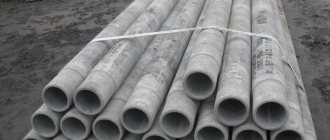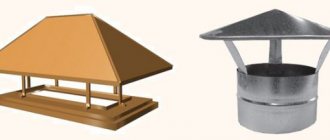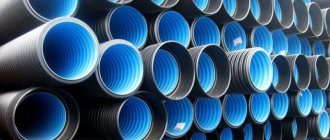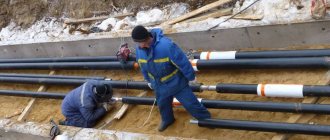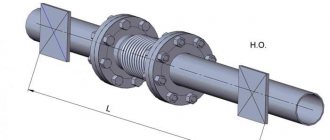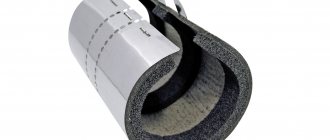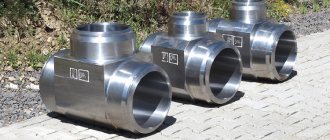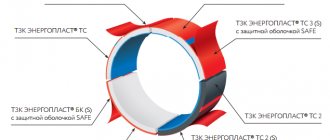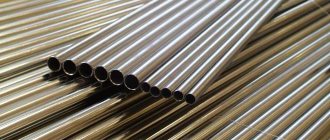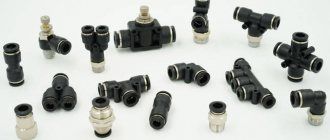Support guide rings (SRU) or supports for laying pipes in a protective case are devices that allow you to pull pipes made of different materials through a protective case (casing): steel, cast iron, polyvinyl chloride (PVC), polyethylene (PE), etc. They center the pipe in the casing by sealing the annular space. Installation of pipes in a case is carried out under various engineering objects: highways, railways.
Using supports, the inner pipe is centered when laying communications in cases
Features of support and guide products
Conventional pipeline supports perform a number of functions. Their main “duty” is to fix the structure. In addition, thanks to the sliding supports, linear expansion of the pipeline has no consequences. And the support-guide rings allow the internal pipeline to be pulled through the outer communication part (case) without causing any harm to it.
Based on this, we can identify several main functions that are carried out thanks to just such a support:
- protection of the pipeline from various damages;
- protection of coupling joints and welds;
- simple and quick pulling of the pipeline through the case;
- support for the supply pipe;
- cathodic protection against corrosion (thanks to this detail, the possibility of contact between the metal frames of two pipes is eliminated).
Note! The use of such rings makes it possible to pull various pipelines that differ in material, diameter, etc. These supports help maintain the integrity of communications both during pulling and subsequent operation.
Installation of these rings is carried out at the assembly stage of the pipeline itself. Their installation does not require the use of special equipment, since the support ring is fixed using electric arc welding. The most common materials for such supports are high-quality polypropylene and steel.
The design feature of the supports makes it easier and faster to pull the inner pipe into the outer one
Control tube
The control tubes are lowered with their free end into the tank to different depths and end at levels corresponding to the controlled volumes. Shut-off needle valves are screwed onto the outer ends of the tubes, the opening of which determines from the exiting gas stream whether it is gas or liquid. To reduce the risk of being struck by a gas stream, a throttle with a diameter of 3 mm is installed in front of the valve. When opening valves to check the level of liquefied gas, operating personnel must always wear gloves on their hands and stand to the side of the valve outlet fitting to prevent the escaping gas stream from hitting the operator, especially exposed, unprotected parts of his body. In cases where the evaporation capacity of the tanks is insufficient to supply gas to consumers, piping the tanks with evaporation units is used.
| Relief safety valve. |
The control tubes are lowered with their free end into the tank to various depths to the levels of the controlled media.
Control tubes are more effective on a gas pipeline that is located above the groundwater level. In some cases, devices are installed that block the gas from leaking into the danger zone and make it easier to detect. A loosened strip of earth allows gas to escape as it spreads from the leak point towards basements and buildings. To control leaks and remove gas in the desired direction, in some cases permanently open drains, similar to control tubes, are installed.
The control tube is a U-shaped tube filled with soda lime and calcium chloride in approximately equal quantities. The layers of calcium chloride and soda lime should be separated at the bottom with a small piece of cotton wool (Fig. 45), and at the top they should not reach 6 mm to the side outlet tubes; they are covered with pieces of cotton wool on top; The tube is closed with stoppers and filled with Mendeleev's putty. Rubber tubes covered with scraps of glass rods are also placed on the side tubes.
| Main characteristics of safety relief valves. |
The control tube (Fig. VI-33) is made of a steel pipe with a diameter of 2, the lower end of which is welded to a casing made of sheet steel 2 - 3 mm thick and 350 mm wide, bent in the form of a semicircle and usually placed above the joint of the gas pipeline. The space between the casing and the gas pipeline is filled with a layer of crushed stone or gravel. The upper end of the control tube is equipped with a stopper, brought to the surface of the earth and protected by KB-ver.
| Control tube device. |
Inspection tubes are of great importance for correct operational supervision; They are the main device that makes it possible to check the density of a gas pipeline from the surface of the earth.
Control tubes can only conditionally be classified as devices that protect underground gas networks from damage. Their main task is not to protect, but to create conditions that allow timely detection of a gas leak from a pipe, take urgent measures to protect the gas pipeline from further damage, as well as eliminate possible consequences of the leak.
Control tubes are installed along the gas pipeline route at certain distances, as well as above points in the gas pipeline for which it is desirable to carry out systematic operational supervision.
| Control device Installation for suction and tubing of gas from the ground. |
Inspection tubes are of great importance for correct operational supervision; They are the main device that makes it possible to check the density of a gas pipeline from the surface of the earth.
Control tubes are brought to the surface of the earth under the carpet in accordance with the requirements of 2 - 1 - 5 of these Rules.
| Reservoir head. |
Benefits of support rings
Support rings, like any other product, have their own advantages. The main advantages of this device include:
- friction indicators when using these polymer devices are reduced to a minimum, so they are considered very reliable;
- thanks to the first point, the protective coating of the pipeline is not damaged during the process of pulling it through the case;
- the speed of installation work is quite high, which reduces the cost of building a highway;
- such supports make it possible to extend the service life of communications as a whole, since contact between pipes is eliminated and the corrosive effect is reduced;
- the supply pipe can be removed if such a need arises;
- the transverse ribs that make up this support may differ in size. This allows internal communication to be carried out in the center of a protective case of any diameter;
- polypropylene is a reliable insulating material and provides reliable cathodic protection of the pipeline.
Installation of external gas pipelines: automated control systems
Such equipment is designed to ensure the highest performance of highways. Automated control systems (APCS RG) have a centralized structure. Their main elements are:
- controlled points (CP) installed on external highways;
- central control center (upper level).
- gas distribution systems (lower level).
The central control center includes several workstations connected via computer networks. Gas pipeline automated control systems are used:
- for the purpose of operational control of distribution;
- equipment condition monitoring;
- accounting for gas receipts and consumption.
Types of supports
Supports for laying a pipeline in a case are differentiated into types depending on the design features. There are three main types of such supports:
1. Support-guide ring, equipped with sliding supports made of polyamide. The latter take the load that is formed due to the movement of the pipe along the case. Dragging steel pipes into the case using such a support significantly reduces friction.
The design of the support ring can have rollers or simple guides
2. Support-guide ring, which includes rolling bearings or, as they are sometimes called, rollers. The number of rollers varies depending on several factors:
- length of the protective casing;
- weight of the pipe being pulled;
- permissible pressure on the anti-corrosion coating.
3. Combined PSCs, which include both types of supports: sliding and rolling. This type is quite popular when laying pipelines of small diameter (up to 30 mm) over long distances - from two thousand meters or more.
In addition to support rings, there are other special devices that are used when pulling the pipeline through the casing. Such products include:
- rubber sealing cuff;
- protective cover for the cuff.
The rubber cuff is used to seal the interpipe space, as well as when repairing communications in a protective case. The protective cover is made of fiberglass and is used to protect the rubber cuff from mechanical influences.
How to install gas pipes inside the house
In the design documentation, the gas pipeline route along the site must be laid in such a way that the pipe enters the wall of a non-residential premises. A boiler room is optimally suited for this purpose. It is the most convenient way to carry out internal gas distribution.
In existing buildings, the rules allow pipes to be laid through living spaces. This applies to situations where the layout of the building does not allow choosing a different option. The gas pipeline, called transit in this case, should not have shut-off valves or threaded connections. This requirement is quite logical. This is explained by the need to prevent gas leakage into living rooms.
To enter a gas pipeline into a house, a hole is drilled in the main wall and a steel sleeve (case) is placed in it. The gaps formed between the sleeve and the wall are sealed with elastic material (rubber sleeve or silicone). The ends of the sleeve must protrude from the wall at a distance of at least 3 cm. Let us immediately note that inserting the pipe through the foundation, as well as laying it under it, is prohibited.
The main method of internal wiring is open. Of course, the appearance of the gas main does not decorate the premises. However, we have to come to terms with this, since this requirement is dictated by security considerations.
The good news for owners who pay great attention to interior aesthetics is that the rules allow hidden installation. It is performed in grooves (furrows) cut into the surface of the walls
They are covered with easily dismantled screens equipped with ventilation holes. Docking of pipework (threaded and welded) laid inside the groove is not permitted. All internal gas pipes, including those laid in a hidden way, must be painted with waterproof paints. At the points where the pipe connects to gas equipment, the rules require the installation of shut-off valves.
What not to do when installing gas pipes internally
The prohibitions regulating installation operations look like this.
- Installation of gas distribution in ventilation shafts is not allowed.
- Thin-walled gas pipes should not cross door and window openings.
- The gas pipeline must be separated from the floor surface by at least 2 meters.
- The length of flexible sections of the highway cannot be more than 3 meters, while ensuring maximum density of joints is mandatory.
- Pipes are allowed to be laid in well-ventilated areas with a height of at least 2.2 meters.
- Wiring is prohibited in places that are difficult to access for inspection and repair. The exception is easily dismantled wall cladding structures.
- The ventilation of the kitchen, where gas pipes will be installed, cannot be combined with other living spaces.
- The finishing of the ceiling and walls located near the gas pipe must be made of non-combustible materials.
- The fastening of the internal gas pipeline must be reliable. For this purpose, steel staples and clamps equipped with a rubber gasket should be used.
There are a number of requirements regarding the relative position of gas distribution and other utilities, household appliances and equipment. Let's list them:
- When laying parallel, the distance between the gas pipe and the electrical cable must be at least 25 cm. If they intersect, the gap must be at least 10 cm.
- The electrical distribution panel must be at least 50 cm away from the gas pipeline.
- There must be a gap of at least 1 meter from the open electrical wiring bus to the gas pipe.
- It is not recommended to place freezers and refrigerators in close proximity to gas distribution. The pipe running behind the refrigerator impairs the ventilation of its radiator grille. As a result, overheating and breakdown of the household appliance may occur.
- Do not install gas pipes behind a gas water heater, or place them close to heating appliances and a gas stove.
- In the kitchen, it is prohibited to lay pipe lines on the floor, under sinks and near dishwashers.
Specifications
PMC is distinguished by its strength characteristics. The materials used in the production of such support rings are capable of withstanding pressure levels of at least 120 kg/cm². The rollers used in some types of support products are also very strong and reliable and can withstand loads of 200 to 300 kg.
Such supports are highly durable and are used when laying highways in any conditions.
Support guide rings (SRU) are used for installation of transitions with cross-sectional dimensions up to 1420 mm. Laying pipes in cases can be done in different climatic conditions. Temperatures at which installation work is permitted vary depending on the specific region, from –40 to +50 °C.
Helpful information! Such rings are securely fixed on the pipes and do not move during installation work and operation of the structure.
The diameter and width of the support depend on the cross-section of the pipeline for which it will be used. This pattern is described in the table below.
Table 1
| Pipeline diameter, mm | Ring diameter, mm | Ring width, mm |
| 1420 | 1642 | 250 |
| 1220 | 1336 | 210 |
| 1020 | 1136 | |
| 820 | 936 | 174 |
| 720 | 856 | |
| 630 | 766 | |
| 530 | 936 | |
| 426 | 542 | 154 |
| 377 | 493 | 130 |
| 325 | 481 | |
| 273 | 420 | |
| 219 | 377 | 100 |
| 168 | 286 | 85 |
| 159 | 277 | |
| 133 | 251 | |
| 114 | 232 | |
| 108 | 236 |
The weight of the product largely depends on the diameter of the product, the data is presented in table No. 2.
table 2
| Pipeline diameter, mm | Ring weight, kg |
| 1420 | 36 |
| 1220 | 30 |
| 1020 | 24 |
| 900 | 18,3 |
| 820 | 17 |
| 720 | 15 |
| 530 | 10 |
| 426 | 9 |
| 377 | 7 |
| 325 | 6 |
| 273 | 5,5 |
| 219 | 5,2 |
| 159 | 4,3 |
| 108 | 3 |
The service life of such a support can reach 30 years (in some cases, more).
Installation of supports
Installation of support rings is carried out in the following sequence:
- The pipeline, which is supposed to be pulled into the protective case, is mounted on supports. During installation, it is necessary to take into account the fact that the lower part of the pipeline must be free for installing the support half-ring.
- A protective gasket is installed on the pipe. A support half-ring is mounted on top of it.
- The second support semi-ring is mounted from below in the same way.
- Both halves are bolted together into a single structure.
- A double guide support ring and a special head, which is equipped with a device for fastening the cable, are mounted at the end of the pulled pipe.
The supports are attached at equal intervals from each other, the distance depends on the type of line, pipe diameter and other factors
In this way, the pipeline is prepared for laying inside the protective case. The distance between the supporting elements is determined taking into account various conditions: pressure exerted on the pipeline, deflection of the communication between the supports, etc. The optimal distance recommended by experts is 3 m.
In addition, for water supply pipelines, the distance between supports may differ depending on the ambient temperature. Cases for water pipes are usually made of steel pipes with an anti-corrosion coating. After the supports are installed, the protective tubes for the cables are installed.
Cost of HDD services
| Pipe diameter | Material | Price |
| 110 mm | Steel | RUB 1,250 |
| 160 mm | Steel | 2,000 rub. |
| 225 mm | Steel | 3,000 rub. |
| 250 mm | Steel | RUB 3,625 |
| 315 mm | Steel | RUB 4,250 |
| 355 mm | Steel | RUB 4,875 |
| 400 mm | Steel | RUB 5,500 |
| 450 mm | Steel | RUB 6,250 |
| 500 mm | Steel | RUB 7,125 |
| 630 mm | Steel | RUB 9,375 |
Features of laying pipes in a case
Installation of pipelines under highways, as well as railway pavement, is always carried out using a case, which acts as a protective capsule for internal communication.
Important! A mandatory rule that must be observed during such work is that the pipe that acts as a case must have higher strength characteristics than the internal one.
The most common option for a pipe-case today is steel products. The popularity of laying pipes in steel cases is due to the phenomenal strength of this material. Depending on the specific case and operating conditions, the following steel pipe options can be used for cases:
- new;
- stale;
- restored;
- used pipes.
Different types of steel pipes are used for laying in the case
The protective case, depending on the situation, can be represented by the following types of pipes:
- welded spiral seam;
- straight-seam;
- seamless hot rolled.
Seamless steel parts are usually used to construct protective cases with a cross-section of up to 273 mm. If the cross-sectional dimensions exceed this figure, then welded spiral-seam or straight-seam products are used.
In addition, steel parts for cases are often equipped with a protective anti-corrosion layer. The protective layer can be represented by the following anti-corrosion coatings:
- sand-cement;
- asphalt-cement-bitumen;
- asbestos-cement;
- epoxy;
- polymer.
Cases for water supply pipes are usually processed with extruded polyethylene. A popular solution for the casing are pipes that were previously used in gas pipelines.
How can highways be laid?
The gas pipeline can be laid underground or above ground. The latest technology is the most economical. The method of laying underground is considered safer. This is how gas pipelines are usually pulled through populated areas. However, the implementation of such a technique is more expensive. Such a highway is also more expensive to maintain.
Some sections of the network in large populated areas can also be laid above ground. But they are almost never too long. Aboveground gas pipeline installation is also provided on the territory of industrial enterprises.
Before starting the installation of the network, it is mandatory to draw up its diagram. The highway project, according to the regulations, must be carried out in topographical terms.
